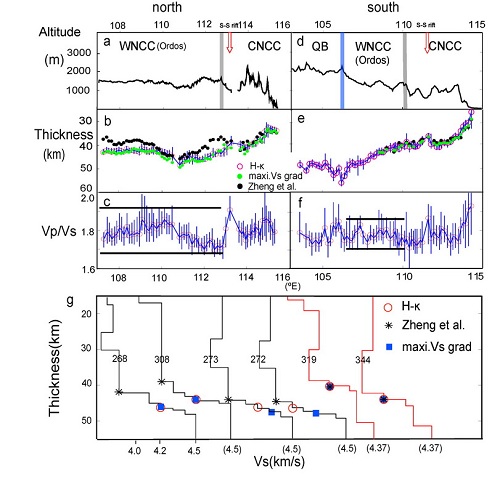Crustal thickness and Vp/Vs ratio of the central and western North China Craton and its tectonic implicationsUpdate time:10 11, 2011
Ph.D. student WEI Zigen and his teacher CHEN Ling investigate the lateral variations in the crustal thickness and ratio of P and S wave speeds using the teleseismic receiver function data recorded at dense seismic arrays. They mainly focus on the different structural features between the northern and southern parts of the Ordos Block. Their observations suggest that distinct structural heterogeneities of the North China Craton (NCC) not only reflect diverse regional tectonics in Phanerozoic, but also provide evidence for long-term survival of crustal fabrics in stable continental interior.
Figure 2. Comparison of altitude (a, d), crustal thickness (H) (b, e), Vp/Vs ratio (κ) (c, f) and crustal velocity structure (g) between the northern and southern profiles. (Image by WEI) Wei et al. Crustal thickness and Vp/Vs ratio of the central and western North China Craton and its tectonic implications. Geophysical Journal International, 2011, 186, 385-389 (Download Here)
|
Contact
Related Articles
Reference
|
-
SIMSSecondary Ion Mass Spectrometer Laboratory
-
MC-ICPMSMultiple-collector ICPMS Laboratory
-
EM & TEMElectron Microprobe and Transmission Electron Microscope Laboratory
-
SISolid Isotope Laboratory
-
StIStable Isotope Laboratory
-
RMPARock-Mineral Preparation and Analysis
-
AAH40Ar/39Ar & (U-Th)/He Laboratory
-
EMLElectron Microscopy Laboratory
-
USCLUranium Series Chronology Laboratory
-
SASeismic Array Laboratory
-
SEELaboratory of Space Environment Exploration Laboratory
-
PGPaleomagnetism and Geochronology Laboratory
-
BioMNSFrance-China Bio-mineralization and Nano-structure Laboratory

 Print
Print Close
Close
